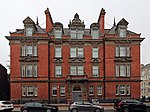Liverpool Institute High School for Boys
1825 establishments in England1985 disestablishments in EnglandAC with 0 elementsAll pages needing cleanupBoys' schools in Merseyside ... and 9 more
Defunct grammar schools in EnglandDefunct schools in LiverpoolEducational institutions disestablished in 1985Educational institutions established in 1825EngvarB from September 2013Grade II listed buildings in LiverpoolGrade II listed educational buildingsHistory of LiverpoolHolt family

The Liverpool Institute High School for Boys was an all-boys grammar school in the English port city of Liverpool. The school had its origins in 1825 but occupied different premises while the money was found to build a dedicated building on Mount Street. The Institute was first known as the Liverpool Mechanics' School of Arts. In 1832 the name was shortened to the Liverpool Mechanics' Institution. The facade of the listed building, the entrance hall and modified school hall remain after substantial internal reconstruction was completed in the early 1990s.
Excerpt from the Wikipedia article Liverpool Institute High School for Boys (License: CC BY-SA 3.0, Authors, Images).Liverpool Institute High School for Boys
Pilgrim Street, Liverpool Georgian Quarter
Geographical coordinates (GPS) Address Website Nearby Places Show on map
Geographical coordinates (GPS)
| Latitude | Longitude |
|---|---|
| N 53.399555555556 ° | E -2.9723055555556 ° |
Address
Liverpool Institute for Performing Arts
Pilgrim Street
L1 9DY Liverpool, Georgian Quarter
England, United Kingdom
Open on Google Maps









